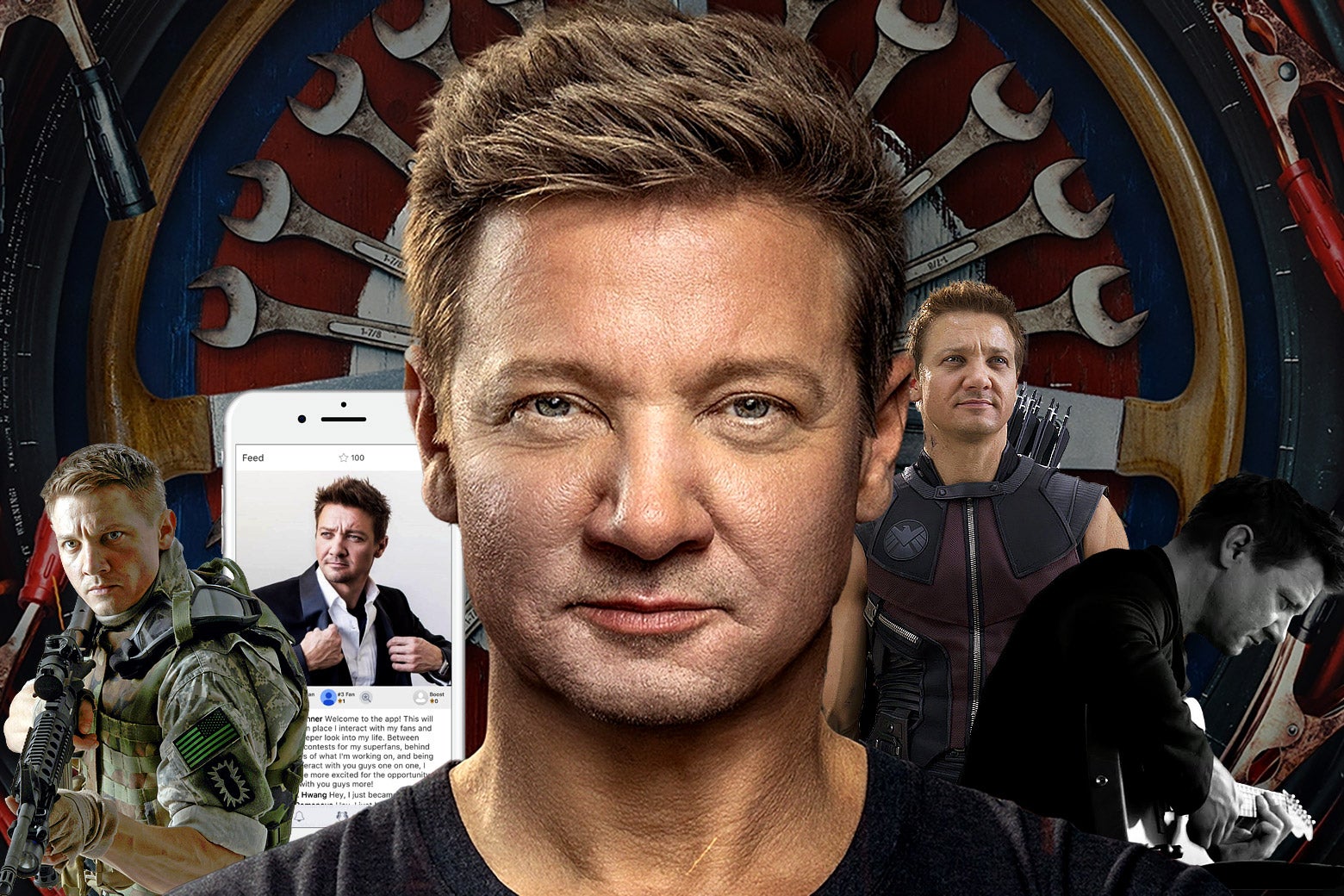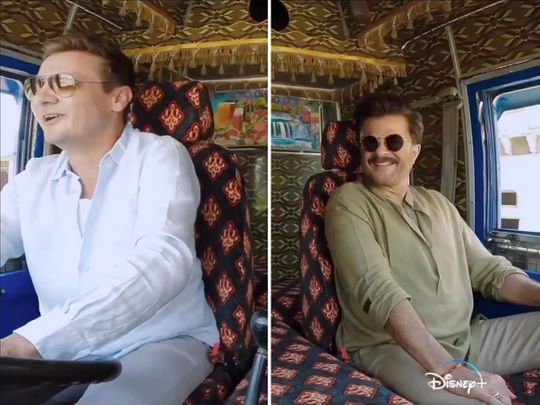What Is Jeremy Renner’s Deal?
The Marvel actor’s inexplicable new series might be the key to finally making sense of this avowedly strange man.

Photo illustration by Slate. Images via Summit Entertainment, Escapex, Marvel Studios, Jeremy Renner/YouTube, and Disney+.
In the third episode of Jeremy Renner’s bewildering, borderline unwatchable Disney+ series Rennervations, the Marvel Cinematic Universe actor delivers his superhero origin story. It begins at Modesto Junior College in California, where Renner first tried acting. Over grainy video of a 1990 Scarecrow pratfalling his way across a stage, Renner intones, “My first play was that Wizard of Oz, was a show.” (That undiagrammable sentence, like so many sentences attributable to Renner, is [sic].) “That’s where I discovered all that wonderment. I discovered all that wonderment there.”
According to Renner, Modesto took this version of The Wizard of Oz to local elementary schools. “This is where I have to think about it, where I’m saying, where …” Renner says on the show, visibly forcing back tears. “It circles to, like, maybe why I’m doing this, you know.” The this that Renner is doing is a four-episode “reality” series in which Renner, along with a group of friends both on payroll and off, refurbishes decommissioned trucks and buses for the ostensible benefit of community organizations around the world. “My love for kids, and my, how I’m inspired by them, and how I am one of them,” he says to the camera, his eyes bright. “How I play make-believe for a living, you know. But to … I mean, I’d do anything for a child.”
During the big reveal in Rennervations’ premiere, when Renner, alongside celebrity friend and fellow Mouse House regular Vanessa Hudgens, delivers a tricked-out “mobile recording studio” to a Chicago nonprofit, we see any number of local kids cheering enthusiastically. Many others look on, confused, at the spectacle of Hawkeye from the Marvel movies high-fiving everyone in sight. Jeremy Renner is not the first celebrity to attempt to use his fame to help those less fortunate than him. He’s definitely the first celebrity to help the less fortunate by driving a modded-out bus onto their street, accompanied by Vanessa Hudgens. Jeremy Renner would do anything for a child. But why’d he have to do this?

When Jeremy Renner made his debut as Hawkeye, in 2011’s Thor, he probably seemed like a safe bet. This was an eon ago in pop culture time, before the Russos, even before Joss Whedon. Renner was coming off two Oscar nominations in three years, for The Town and the Best Picture–winning The Hurt Locker, and he must have seemed at the time like a rising-star addition to a roster of heroes that was just beginning its exponential growth.
But Hawkeye’s never really had a breakout moment in the series, and it’s seemed clear that the character’s tendency to fade into the background stems as much from the actor’s own dullness as the franchise’s inability to come up with anything great. (Renner’s appearances in the Mission: Impossible and Bourne franchises, as the ostensible successor to Tom Cruise and Matt Damon, never seem to go anywhere either.) Hawkeye broods, he shoots arrows, he goes home to his family—a workaday superhero whom the producers have struggled to make connect with audiences. Renner, to his credit, has never overestimated his character’s prospects. “I’m happy to be the ensemble,” he said in 2014. “I’m not scratching or clawing to do a solo movie by any means.” When Hawkeye finally did get a solo property, a 2021 Disney+ series, its goal was clearly to ease Renner out of the MCU, to be replaced by Hailee Steinfeld, the real star of that show.
What’s always been puzzling about Renner, though, was the gulf between his realism about Hawkeye’s appeal and his cockeyed optimism about his own. How else to explain, for example, the Jeremy Renner app? Launched in 2017, the app, called “Jeremy Renner,” was a quixotic attempt to create a haven for lovers of Jeremy Renner. Essentially a walled-garden version of Instagram in which members could compete for the title of No. 1 fan, the app survived for two years of “Happy Rennsdays,” though not without drama. The creators of the app eventually learned that, as with all social media experiments, if you don’t invest in content moderation, things get ugly fast. “It’s not censoring. I wouldn’t say censoring,” Renner’s business manager (and “brother” and longtime roommate?) Kristoffer Winters told the Ringer. “It’s just that, if someone says something to somebody that is nasty, we’ve decided to block them.”

“The app has jumped the shark. Literally,” Renner wrote in a typically Rennerian app update before shutting it down in 2019. Renner’s final message is such a howl of disappointment and frustration it hurts the heart to read it. “What was supposed to be a place for fans to connect with each other has turned into a place that is everything I detest and can’t or won’t condone. My sincere apologies for this to have not turned out the way it was intended.” What it turned out to be was the internet—in a nutshell, comedians found it and started messing with it—but it’s touching to understand that Jeremy Renner sincerely felt he had created something too beautiful to last.
That same aching sincerity animates much of Renner’s non-MCU activity. You certainly cannot accuse him of half-assing his job, which he appears to believe is delivering the max possible level of Jeremy Renner. Put him in a comedy called Tag, and he’ll break both his own arms. (He continued filming, and the filmmakers used CGI to edit out his casts.) Give him his own Amazon store, and he’ll give you a photo shoot in which he very earnestly misuses the very piece of outdoor equipment he’s attempting to hawk. “It’s weird not to be weird,” proclaims the introduction to Renner’s YouTube channel (quoting John Lennon, who likely never said that), a channel that features mostly lyrics videos for Renner’s many songs.
Ah, yes, the songs. The only thing “weird” about them is how desperately unweird they attempt to be. They are punishingly sincere: straight-down-the-middle rock songs with Renner’s growly, well-processed voice front and center. The titles are blunt and declarative: “Live for Now.” “She’s a Fire.” “Love Is a War.” They sound, in a way, like an A.I.’s attempt to generate an arena-rock standard. Take his 2019 track “Heaven Don’t Have a Name,” with its lyrics so empty of meaning as to function as koans:
She keeps it old school
Feels like rock and roll
But got that new groove
So unpredictable
I gotta tell you
I’ll never be the same
Heaven don’t have a name

Twitter, with its well-tuned ear for gormlessness, responded to this effort exactly as you might expect. (“Heaven don’t have a name. Except for Heaven, which is its name.”) Yet if there’s any celebrity who I believe neither reads nor cares about what Twitter has to say about him, it’s Jeremy Renner. And good for him! He’s got a business with Winters renovating and flipping houses. They do beautiful work. He lives in a gorgeous mansion outside Reno, Nevada, with its own recording studio and on-site sound engineer. Though Renner is currently recovering from a terrible New Year’s incident in which, after Rennervations finished filming, he was rolled over by his own enormous snowplow—he’ll talk about the experience in an exclusive interview with Diane Sawyer premiering Thursday—it’s clear that he has filled his life with the things he loves best: music, giant vehicles, and buddies.
Rennervations is, truly, a loving ode to giant vehicles and to buddies. That’s a much easier way to think of it, at least, than trying to understand the show’s ostensible raison d’être. Rennervations’ philanthropic hook is so baffling that every episode begins with a sit-down interview in which Renner endeavors to explain what the hell is going on. “I’m buying these decommissioned government vehicles to help reimagine them to serve this community again, just in a different way,” he says. It is evident, from the impatience in his voice, that he can’t believe that no one seems to get it. At the end of the interview segment, his buddy Rory asks him to sum it all up. Renner looks straight at the camera and delivers this inspiring, definitely unscripted manifesto: “I want to make actionability and thoughtfulness of others cool as [bleep].”
“You can’t say [bleep] on Disney, dude,” Rory protests.
Renner grins in what he believes to be a devilishly charming manner. “We just did!”
Rennervations may be delivering giant vehicles to various community organizations, but basically Renner wrangled Disney money to hang out with a bunch of gearheads and builders in a giant warehouse. Renner’s team, a cheerful group of dirtbag Avengers with superhuman fabrication and electrical skills, takes the eccentricities of their patron in good grace. Many of them come from the off-road racing community, and—like that sound engineer who, according to Renner, “lives in” Renner’s home recording studio—they seem to have been hired, essentially, to be Renner’s friends. They all appear to understand that with that job come some absurdities. The frequent requests to “plus this thing up a bit.” The requirement to say things to the camera crew like “I’m super proud of Jeremy for his crazy idea of what we could do.” The artificial deadlines: Each job, for no good reason but TV drama, absolutely must be done in two weeks.
And the razzing! Rennervations is not a good reality show, but it would make an incredible source text for a doctoral thesis on homosocial relationships between modern dudes. They all love one another, but boy do you have to wade through a lot of bullshitting to get to the love. “At least you can still weld, ‘cause your looks have really gone downhill!” “That looks like Rory’s hair!” Indeed, much of the razzing is directed at Rory, last name Millikin, a producer on the show, a longtime Renner buddy and the president of the “first company to receive a patent to cold-press cannabis into juice.” Rory’s there to be the everyman and the fish out of water—when he tries to use an electric ratchet, he almost kills himself—but he also tries to keep Renner focused. (It’s not an accident it’s him handling that opening Q&A, which seems to have been recorded late in the game, after someone panicked that no one understood what, exactly, the show was.)
The camaraderie of all the dudes is almost enough to drag Rennervations into watchability. (Even the women on the crew are dudes: One, Merri, cracks wise about the off-road truck crash that wrecked her short-term memory.) But then you think about the poor nonprofits dragged into this mess. I am sure that the kids of Chicago love music, though the show never shows us any of them singing or rapping or picking up one of the mobile recording studio’s many expensive guitars. When I emailed BASE Chicago—the nonprofit that focuses on baseball and softball for at-risk kids and was the recipient of this gift—to ask if the organization was using the vehicle, its executive director responded to tell me the kids love it, and they recently recorded a song in it that’s gotten “almost 1 million plays.” (The song? A cover of Jeremy Renner’s “Nomad.”) But I can’t help but wonder what will happen when the ingenious but delicate power source one of Renner’s fabricators jury-rigged for the bus—literally 20 car batteries on a pallet, all hard-wired together—breaks down. What mechanic in Chicago is gonna fix that, I thought at the end of the episode, as, for the second time, I watched a passionate Renner play “House of the Rising Sun” on the piano, this time for a group of bemused inner-city kids.

The episode of Rennervations set in India really lays bare the solipsism driving the enterprise. For this one, Renner is joined by Anil Kapoor, the gaudy, garrulous Bollywood actor known to American audiences from Slumdog Millionaire. (“Rory, his hair’s better than yours!”) Kapoor knows what the cameras want, and so we get copious footage of him declaring that his Mission: Impossible pal is “so generous, which I think is the hallmark of a good human and a good actor.” Meanwhile, Renner’s arbitrary two-week deadline to transform a truck into a mobile water-purification station has driven the two local crew chiefs mad. Working doggedly in the midst of a historic heat wave, the two fabricators, longtime friends, fight with each other and with the subcontractors they’ve hired. It’s torture to watch these two run themselves ragged for the sake of Jeremy Renner’s vanity, torture to watch Anil Kapoor shout “You have to do it for India!” at them.
And yes, it’s gratifying, at the end, to watch Renner drive that truck into a Rajasthan village and hook it up to the town’s well. But what if Renner had just taken the entire budget of Rennervations, split it in four, and given the cash to these nonprofits? Imagine the ways they could have used that to fulfill, or even expand, their missions! Think of the actual children that would have helped! Obviously that would have been better than saddling them with difficult-to-maintain vehicles born from one Hollywood star’s wonderment at dudes who can weld. Jeremy Renner still thinks of himself as a child, one who gets to play make-believe for a living. Rennervations is evidence that once you reach a certain level of fame, your entire world can become make-believe, if you wish upon a star.







